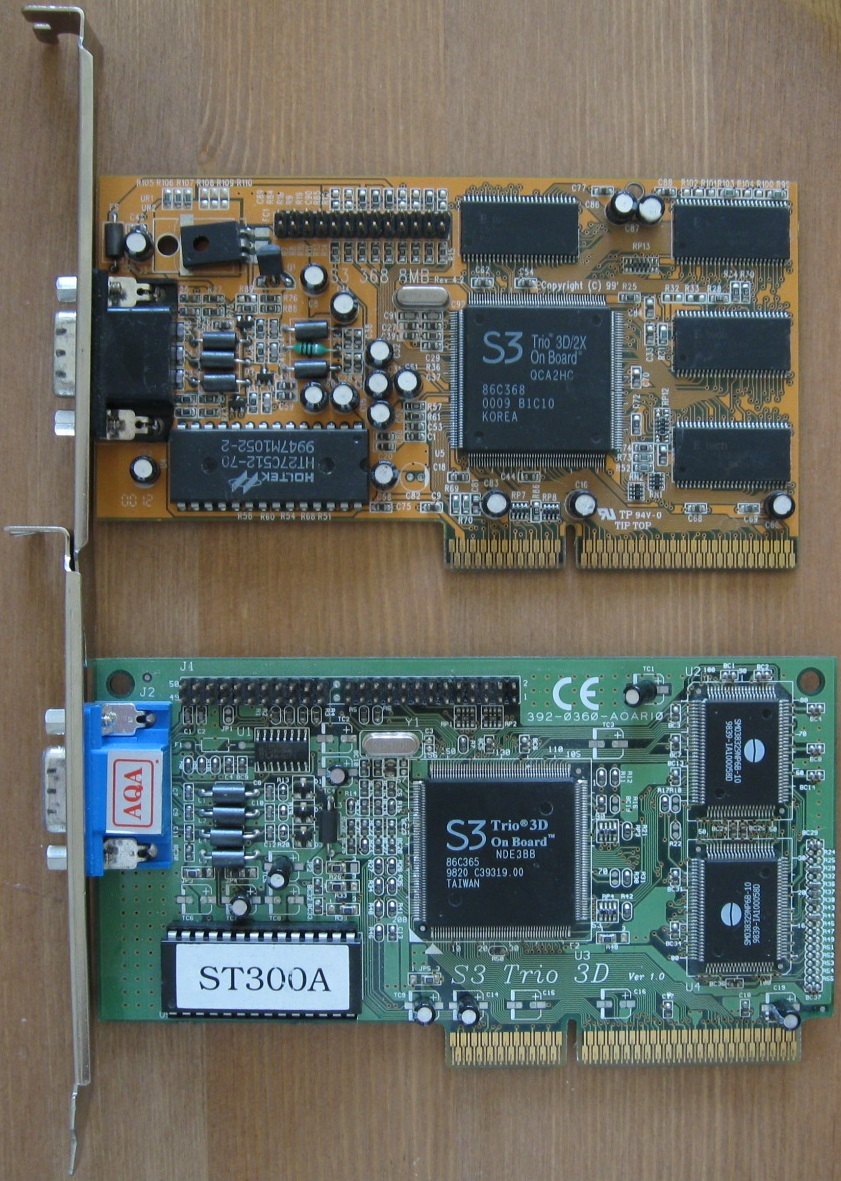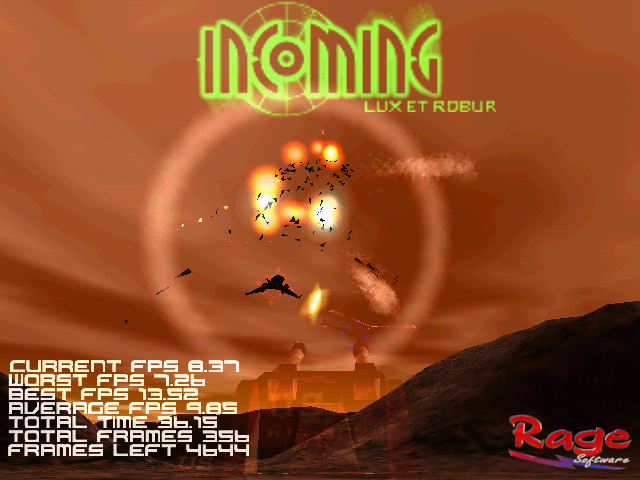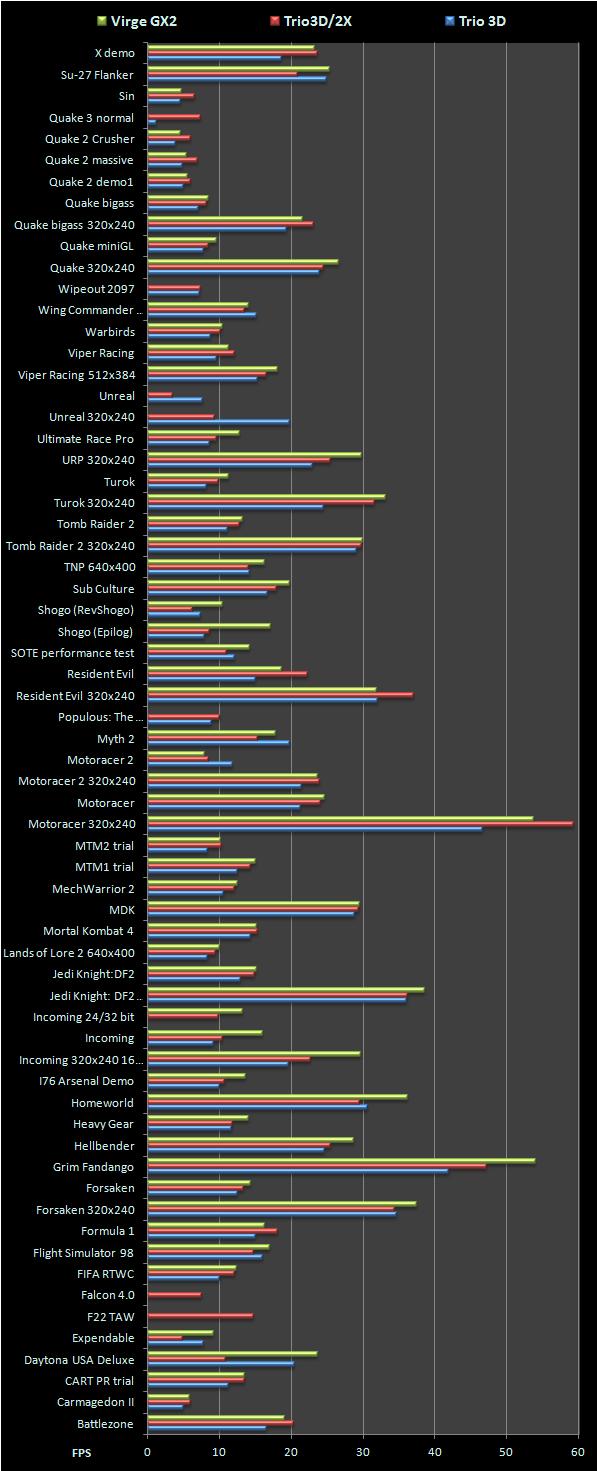Virge on life support
After the release of last Virge in summer of 1997, out featured and outperformed since day one, S3 was going to have a tough time because their next generation architecture was still one year away. This long window was to be filled with yet another respin of S3d architecture. Undeniably no longer acceptable for any true gamer, S3 decided to use it's immensely successful Trio brand. Thus the name Trio3D does not raise much hope for 3D gaming, it should probably merely imply that 2D line of accelerators just became 3D capable- at whatever performance. The product was positioned as a SOHO productivity solution and as such became quite successful at OEM builds. Thanks to its aggressive pricing it spread even to gamers on extreme budget. What were they going through in 1998?
Trio3D
Trio3D offered great 2D and video acceleration with it's new 128 bit engine. S3 however, did not go into details describing 3d engine. There are two clear reasons for that- different positioning and ancient Virge architecture. Fortunately, there were significant features added to stay in touch with the rapid development. "Business-Ready" Trio3D chip should support all important alpha blending modes, which should greatly improve 3d quality over Virge. However, much needed performance enhancements are nowhere to be found. There is a command interface, increasing bus efficiency and support for 8 MB of memory but neither of those can really help. Trio3D typically features 4 MB of SGRAM and such card is in the test. The 10ns memory is ticking at 100 MHz and core clock does not seem to raise over old classic models. For some reason overclocking headroom is gone, one is lucky if he can go beyond 110% percent. Trio3D/2X with newer SDRAM is doing better, my card in test could overclock by 20%+ and others with lower default clocks had headroom even higher. But for my tests I picked a card with 100 MHz default memory clock, to compare directly with GX2 and first Trio3D. Trio3Ds drivers have CommandDMA enabled by default and this setting is unusable on my main test rig with KT133 chipset. I tried those cards in motherboard with SiS 735 and the DMA is working fine there. Performance can go up by even 10%, but only in low resolutions where fillrate limits are avoided. To remain comparable with previous tests my benches were done in same KT133 board with CommandDMA disabled.

Trio3D/2X is yet another refresh, from 1999. 2d part was updated once again and this time even 3d performance was improved. There are actually new features, which is surprising given target consumer. AGP 2x is supported with texturing from system memory. That is rather cosmetic improvement since most of 2X cards carry 8 MB of memory, more than enough for such anemic architecture. Being a 1999 product, Trio3D/2X utilized often SDRAM, which means no more block writes support. S3 came out of the closet and pulled back multiplicative alpha blending support that first Trio3D was failing in and old Virge could not do either. That is the only technical deficiency of last "decelerator" incarnation. Drivers for 2X are distinctively different and surprisingly compatible with some modern 3d programs.
Experience
 Trio3D fixed Lens Flares, but added new issues.
For more screenshots see the Trio3D gallery.
Trio3D fixed Lens Flares, but added new issues.
For more screenshots see the Trio3D gallery.
How are games on Trio3D, how did the support for all blending modes helped? Well the answer is rather negative, reality is much harsher than exposed features. First disaster is a bit missing from texture colors and as many users of earlier ATi chips know, 5550 format is causing heavy banding. Many mistakes of older Virge are repeated: HUD problems of Formula 1, bilinear filtering in Daytona USA is on strike, most of 2D art in Populous is invisible, broken reflection map and texture transparency in Monster Truck Madness 2, broken transparency in Motoracer 2, corrupted ground textures in Mechwarrior 2, Shogo suffers from disappearing textures, world texturing in Thief is still impossible. Unreal runs, but with proper lighting Trio3D gives up on texturing, so I tested flat shaded. Then there are new errors like transparent objects in Incoming, transparent characters in Mortal Kombat 3. Among complete failures are NHL 99, freezing Falcon 4.0 and F22 is missing too many textures. I got Sin to work with Mpact wrapper, some textures are missing and HUD is wrongly blended though. With TechlandD3D library I could get Quake 3 demo tested, however light mapping has to be disabled to get anything recognizable out of the game.
 Trio3D/2X fearlessly pushes 1996 based 3d architecture into new millenium.
For more screenshots see the Trio3D/2X gallery.
Trio3D/2X fearlessly pushes 1996 based 3d architecture into new millenium.
For more screenshots see the Trio3D/2X gallery.
Yes, Trio3D/2X without lightmaps is getting close to proper Quake 3 rendering. Sure, there are still several things this chip just cannot do. Unreal can be rendered with proper lighting, inevitably very slow and certainly with plenty of bugs left, but to get so much out of such ancient architecture is kind of admirable. Half Life is textured, but flat shaded and with own fair deal of transparency issues. Even 3DMark2001 runs - somewhat. Dithering to 16 bit causes same heavy artifacts on transparent textures like with old Virge, fortunately Trio3D/2X returned with support of 24 bit depth rendering, 5650 and 8880 textures. Of course there are exceptions from the rule, for example Battlezone is properly rendered only by Trio3D, 2X adds funky colors on some surfaces and broken particles. Similar color problems are ruining Formula 1 and smaller troubles are seen in Falcon 4.0 and Viper Racing. Video textures in Mortal Kombat 3 are suddenly missing. 2X seems to be the only Virge based chip capable of reflection maps, nice option even if the cost is extra pass.
Performance
Finally how fast are those cards? Trio3D is a letdown in this regard as well, it does not match GX2 and performs at the level of MX. Which makes me think the core cannot be clocked higher than MX, or some new features, no matter if correctly implemented, are dragging Trio3D down. Trio3D/2X is doing better, when framerate drops significantly below GX2 it is in situations where it draws games with effects old Virges could not. This puts it half way between MX and GX2 framerates, but image quality is up a notch. Thus I consider 2X with 100 MHz memory the most powerful Virge based card. However bad news for retro gamers is lower compatibility with S3d titles. In minimal framerates both Trios lag a few percent more behind GX2.

Last words
Outside of 3d games Trio3Ds did their job and S3 was holding significant market share thanks to them. The addition of subtractive blending is nice but insufficient. S3 dragged Virge into times with no tolerance for lack of multiplicative alpha blending and such low performance. Since some gamers could not avoid Trio3D, it did not help with company reputation among them. First Trio3D is a mess of incompatibilities, 3d drivers are just unfinished. Trio3D/2X gives better impression, far from perfect, but has some "cool" factor as Virge architecture most compatible with benchmarks past 90's. Good for geeks, but completely out of place in 1999. Weren't Savages cheep enough? First Trio3D could cut a bit of time waiting for August until Savage3D was ready in August. It was an adequate budget 3D chip, but corporate world might respond better to continuation of Trio line rather than product clearly made for games. Savage suffered from poor drivers as well, but it was the right path. Version MX/IX with memory in single package with chip reduced power draw and cost, helping integration to motherboards. In spring 1999 S3 came with Savage4 and considering what it was, it showed quite a muscle and was actually selling well. For the second half of the year S3 aimed even higher with their first dual pipeline architecture with Transform and Lighting unit. But new hope quickly vanished when Savage 2000 failed performance expectations and the TnL unit turned out defected. At this low point VIA, big partner still in need of integrated graphics, moved in for acquisition. S3 went through restructuring which probably delayed following Savage XP chip too much. It was essentially only updated Savage 2000 done right and was recalled at the last moment in April 2002. Next high performance architecture was coming on schedule and that was DeltaChrome S8. However, despite strong specifications there was a widening gap between the efficiency of S3 and two biggest competitors. Chrome series continued with less ambitious chips, their few highlights being low power consumption and HTPC value. While S3 lives till today, owned by HTC, they have remained silent since 2010 and nobody really believes they could ever make it back.